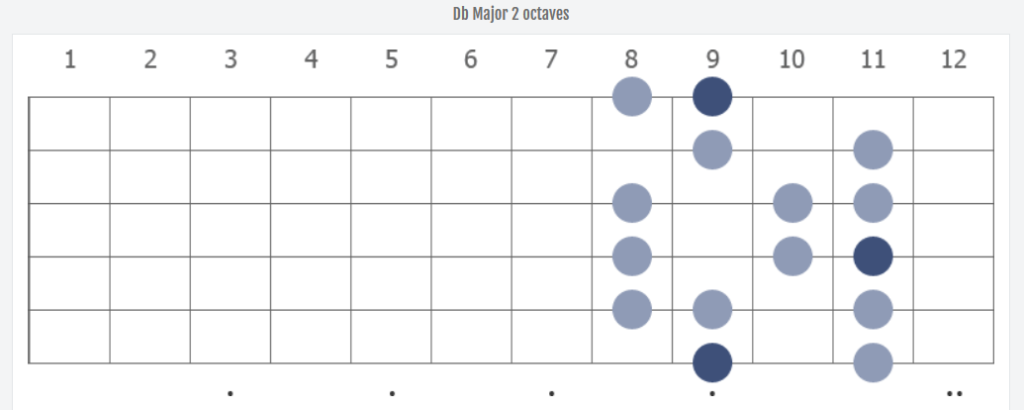What You Need To Play D-flat Major Scale On Guitar

The D-flat Major Scale on Guitar
The D-flat major scale, known for its rich and warm sound, is a foundational element of guitar music across various genres. While it might seem daunting at first due to its flat notes, mastering this scale opens up a world of musical expression and technical proficiency.
In music theory, a major scale is a diatonic scale made up of seven distinct notes, plus an eighth that duplicates the first an octave higher. The D-flat major scale is no different, but what sets it apart is its unique tonal quality and the way it resonates on the guitar.
This scale is particularly noteworthy for its use in jazz, blues, and classical music, offering a distinct sound that can add depth and emotion to your playing. Whether you’re a budding guitarist or an experienced player looking to expand your musical vocabulary, learning the D-flat major scale is a step towards greater musical versatility.
We’ll explore the basics of the D-flat major scale, specifically tailored for guitar players. We’ll look at the scale’s composition, its position on the guitar fretboard, and the fundamental techniques required to play it effectively. By the end of this guide, you’ll not only understand the scale’s structure but also be well on your way to incorporating it into your own guitar playing.
Stay tuned as we dive deeper into the world of the D-flat major scale on guitar, a scale that once mastered, will enhance your musical repertoire and bring a new level of sophistication to your playing.
Understanding the Guitar Fretboard for the D-flat Major Scale

To effectively play the D-flat major scale on the guitar, it’s crucial to have a good understanding of the guitar fretboard. The fretboard may appear complex at first, but with some basic knowledge, you’ll find it easier to navigate.
The Layout of the Fretboard
A standard guitar has six strings and a series of frets. Each string represents a different musical note when played open, starting from the thickest string (E, A, D, G, B, E). As you press down on different frets along these strings, you change the pitch of the note.
Locating D-flat on the Fretboard
To begin playing the D-flat major scale, you first need to locate a D-flat note. On the guitar, D-flat is the same as C-sharp (Db and C# are enharmonic, meaning they sound the same but are written differently). The most common starting points for the D-flat major scale are.
- On the 4th fret of the A string (5th string).
- On the 9th fret of the E string (6th string).
Understanding the Scale’s Notes
The D-flat major scale consists of the following notes- D-flat (Db), E-flat (Eb), F, G-flat (Gb), A-flat (Ab), B-flat (Bb), C, and then back to D-flat (Db) an octave higher. On the guitar, these notes can be found across different strings and frets, and there are multiple patterns to play the same scale.
It’s important to remember that the D-flat major scale, like all scales, is a sequence of whole steps and half steps. In the case of the D-flat major scale, the sequence is- whole, whole, half, whole, whole, whole, half.
Visualizing the Scale
One effective way to understand the scale is by visualizing it on the fretboard. Many guitarists find it helpful to use fretboard diagrams, which show where each note of the scale is located on the fretboard. (Consider including a fretboard diagram here to illustrate the scale.
By familiarizing yourself with the location of these notes on the guitar, you will be able to navigate the D-flat major scale more fluently. Up next, we’ll dive into the specific finger positions and techniques to play this scale smoothly and accurately on your guitar.
Finger Positions and Technique for the D-flat Major Scale
Having familiarized ourselves with the D-flat major scale’s notes and their positions on the fretboard, let’s now focus on how to play this scale with proper finger positions and technique.
Basic Finger Positions
When playing scales on the guitar, each finger is generally responsible for a fret in a four-fret span. For the D-flat major scale starting on the 4th fret of the A string (5th string), you would typically assign your fingers as follows.
- Index finger (1st finger) for the 4th fret.
- Middle finger (2nd finger) for the 5th fret.
- Ring finger (3rd finger) for the 6th fret.
- Little finger (4th finger) for the 7th fret.
Playing the Scale
- Starting Position: Begin with your index finger on the D-flat (4th fret of the A string). This is your root note.
- Ascending the Scale
- Play E-flat (6th fret on the A string) with your ring finger.
- Move to the D string and play F (3rd fret) with your index finger, followed by G-flat (4th fret) with your middle finger and A-flat (6th fret) with your ring finger.
- On the G string, play B-flat (3rd fret) with your index finger, C (5th fret) with your ring finger, and finally reach the higher octave D-flat (6th fret) with your little finger.
- Descending the Scale
- Reverse the process, starting from the higher octave D-flat on the G string and moving downwards, using the same fingerings in reverse order.
Technique Tips
- Economy of Movement: Keep your movements as minimal and efficient as possible. Avoid lifting your fingers too far from the fretboard.
- Alternate Picking: Use alternate picking (down-up motion) with your pick for a smoother sound and greater speed.
- Clean Transitions: Practice moving between strings smoothly, aiming for a legato sound where each note flows into the next.
- Hand Position: Keep your thumb at the back of the guitar neck for better reach and finger flexibility.
Practice Slowly
Initially, practice the scale slowly, focusing on clean note articulation and proper finger placement. Speed will come with time and muscle memory.
This fundamental approach to finger placement and technique will not only help you master the D-flat major scale but also lay a solid foundation for advanced guitar playing. In the following sections, we will explore scale patterns across the guitar neck and practical exercises to enhance your skills.
Scale Patterns on the Guitar Neck for the D-flat Major Scale
Mastering the D-flat major scale on the guitar involves learning various scale patterns across the neck. These patterns enable you to play the scale in different positions, offering versatility in your playing. In this section, we’ll explore some common scale patterns for the D-flat major scale.
Understanding Scale Patterns
Scale patterns are specific ways of playing scales that span across several frets and strings. These patterns are designed to make use of the guitar’s unique tuning and fretboard layout, allowing for efficient and fluid movement.
Pattern 1- Open Position

- Position: Start with the root note D-flat on the 4th fret of the A string.
- Fingering: Follow the finger positions outlined in the previous section, stretching from the 4th to the 7th fret.
- Movement: This pattern involves playing notes on the A, D, and G strings, covering two octaves.
Pattern 2- Fifth Position

- Position: Start with the root note D-flat on the 9th fret of the E string (6th string).
- Fingering: Use a similar finger-per-fret approach, starting with your index finger on the 9th fret and stretching to the 12th fret.
- Movement: This pattern covers the E, A, and D strings, again spanning two octaves.
Advantages of Learning Multiple Patterns
- Flexibility: Knowing various patterns allows you to play the D-flat major scale in different positions, giving you more options for improvisation and composition.
- Fretboard Mastery: As you learn these patterns, you’ll gain a deeper understanding of the fretboard, helping you navigate it more intuitively.
- Musical Expression: Different patterns can offer unique phrasing options, adding to your expressive capabilities as a guitarist.
Practice Tips
- Start by playing each pattern slowly, focusing on clean note articulation.
- Gradually increase speed as you become more comfortable.
- Practice transitioning between different patterns to build fluidity in your playing.
As you become more familiar with these scale patterns, you’ll find that the D-flat major scale offers a wide range of musical possibilities on the guitar. In the next section, we’ll delve into some exercises to help you practice the scale effectively.
Practicing the D-flat Major Scale on the Guitar
Now that we’ve explored various scale patterns for the D-flat major scale, it’s important to focus on practicing these patterns to enhance your proficiency. Effective practice not only involves repetition but also incorporates various exercises to develop your technical skills and musical ear.
Exercise 1- Ascending and Descending
- Objective: To gain fluency in playing the scale both upwards and downwards.
- Method: Start with the first pattern in the open position. Play the scale slowly from the lowest note to the highest, then back down. Focus on even tone and rhythm.
- Progression: Gradually increase the tempo as you become more comfortable. Then, apply the same method to the second pattern.
Exercise 2- Interval Jumps
- Objective: To develop finger independence and improve your ability to navigate the scale non-linearly.
- Method: Instead of playing the scale in sequence, jump between intervals. For example, play the first note, then the third note, then the second, then the fourth, and so on.
- Variation: Experiment with different interval patterns to challenge yourself further.
Exercise 3- String Skipping
- Objective: To improve your picking accuracy and hand synchronization.
- Method: Play the scale but skip strings. For instance, play a note on the A string, then a note on the G string, and continue in this pattern.
- Tip: Start slowly to ensure accuracy, then increase speed as your comfort level grows.
Exercise 4- Scale in Context
- Objective: To practice applying the D-flat major scale in a musical context.
- Method: Create or learn simple melodies or riffs within the scale. Try improvising over backing tracks in D-flat major.
- Benefit: This helps in understanding how the scale can be used musically, beyond just technical exercises.
Practice Tips
- Consistency is Key: Regular, focused practice is more effective than sporadic, lengthy sessions.
- Use a Metronome: This helps develop a strong sense of timing and rhythm.
- Listen Carefully: Pay attention to the sound of each note. Aim for clarity and expression.
- Record Yourself: Listening back to your playing can reveal areas for improvement.
By incorporating these exercises into your practice routine, you’ll develop a deeper understanding and greater mastery of the D-flat major scale on the guitar. In the next section, we’ll explore how to apply this scale in creating music, from solos to compositions.
Section 6- Application in Music – Using the D-flat Major Scale
Having developed a good grasp of the D-flat major scale through various exercises, it’s now time to look at how this scale can be applied musically. The D-flat major scale is not just a series of notes; it’s a tool for musical expression.
Creating Melodies and Solos
- Melodic Composition: Use the notes of the D-flat major scale to create melodies. Experiment with different rhythms and phrasings.
- Soloing: When soloing in the key of D-flat major, utilize the scale patterns you’ve learned. Try to emphasize the root, third, and fifth notes of the scale to create a sense of resolution.
Improvisation
- Backing Tracks: Practice improvising over backing tracks in D-flat major. This not only improves your scale fluency but also helps develop your ear for this key.
- Experimentation: Don’t be afraid to experiment with different note combinations and rhythms. Improvisation is a creative process.
Section 7- Tips for Mastery – Beyond the Basics
Mastering the D-flat major scale on the guitar is an ongoing journey. Here are some tips to take your skills beyond the basics.
Practice Mindfully
- Quality Over Quantity: Focus on the quality of your practice. It’s better to have a shorter, more focused practice session than a longer, unfocused one.
- Set Goals: Have clear objectives for each practice session. Whether it’s mastering a particular pattern or improving speed, having a goal helps you stay focused.
Explore Music Theory
- Understand Scale Relationships: Learn how the D-flat major scale relates to other scales and chords. This knowledge can enhance your improvisation and composition skills.
- Study Modes: Explore different modes of the D-flat major scale to broaden your musical vocabulary.
Expand Your Repertoire
- Learn Different Styles: The D-flat major scale is used in a variety of music styles. Experiment with jazz, blues, classical, or even rock to see how each genre utilizes the scale differently.
- Transcribe Solos: Listen to solos by accomplished guitarists and try to transcribe them. This can provide new insights and inspiration.
Keep Challenging Yourself
- Speed and Accuracy: Continually challenge yourself to improve your speed and accuracy with the scale.
- New Patterns: As you become comfortable with the basic patterns, explore more complex scale patterns and positions on the fretboard.
Author: Daniel Powers Jr, the founder of Real Brave™, serves as the chief inspiration to thousands of students in the Real Brave music instruction program. He’s also the visionary behind PracticePad™, an online platform for live one-on-one online music lessons, lesson tracking, and scheduling. Beyond his entrepreneurial pursuits, Daniel leads a non-profit organization that provides formerly homeless children with access to music education, making a profound impact on their lives. His unwavering dedication to music, innovation, and education continues to inspire individuals to reach their fullest potential while creating positive change in communities. Follow Real Brave on all the socials:
youtube.com/@realbraveinc
twitter.com/realbraveinc
https://www.tiktok.com/@realbraveinc
instagram.com/realbraveaudio
facebook.com/realbraveinc




